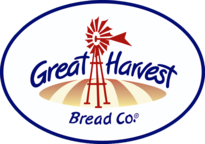MADE FROM SCRATCH DAILY!
BREAD. THE WAY IT OUGHT TO BE.

WHEN IT COMES TO BREAD, LESS IS MORE.
“We keep our ingredient lists tight, sometimes just five items,” Melissa Miller said. Miller is a Registered and Licensed Dietitian and Nutrition Specialist for Great Harvest Bread Company. She works to monitor ingredients and allergens as well as provide nutritional information for the Company’s more than 200 bakeries across the U.S. “Our whole-grain breads make me really proud of what I do,” said Miller, a graduate of Colorado State University. “We use better quality ingredients for stronger nutritional content and better flavor.
”We at Great Harvest Bread Company do not use additives, dough conditioners, emulsifiers or preservatives to keep loaves on the shelf for an extended period or unnaturally improve texture and size. We rely on natural chemistry to preserve our bread and make it delicious!
Take the Honey Whole Wheat loaf – Great Harvest Bread Company’s signature and most popular bread. As bakers knead together freshly milled, whole wheat flour, pure honey, filtered water, salt and yeast, the ingredients work together to create dough that bakes into naturally long-lasting bread with a surprisingly long shelf life. Don’t be fooled – it takes time to developing the natural chemistry that allows bread to stay fresher longer. “Most commercial bread companies don’t want to find and rely on skilled bakers who care about their products and will come in at 2 a.m. to knead dough and give it the time it needs to rise,” Miller said. “They’ve developed additives to speed up the process; we rely simply on the hands of our bakers and time to make our bread delicious and lasting.
”We mill each batch of flour fresh in store, which retains the most nutrients and best flavor possible. “It’s the same as coffee,” Miller said. “You can tell the difference between ground coffee that’s sat in a can for months and the local beans you just ground at home. Same thing totally applies to flour.”
“People will note that our bread fills them up more than other breads,” Miller said. “Your body has to work to digest and break it down, which helps you feel full longer and burns extra calories.
”Finding quality bread is trickier than most might think. Bread packaging can be ambiguous, which is why it is important to be educated in label reading. “Don’t look at the whole grain statements on the front, they can be misleading,” Miller said. “Check the ingredients list on the label and look for ‘whole grain.’ If it just says ‘9 grain’ or ‘multi grain,’ you’re not necessarily getting 100 percent whole grain bread.”
Miller’s favorite bread is Great Harvest Bread Company’s Dakota loaf, with pumpkin, sunflower, millet and sesame seeds kneaded into the Honey Whole Wheat dough. She also recommended the Company’s newly developed Superfood Bread, featuring quinoa, flax, oat bran, and hemp seeds, blended with delicious ingredients like locally sourced honey. “We care a lot about the ingredients as well as the flavor,” she said. “If the nutrition is there but there’s no flavor, no one will eat it. We taste test everything we do.”
Part of Miller’s job is keeping up with the changing US Food and Drug Administration (FDA) regulations. In November, the FDA passed a regulation requiring restaurants and food establishments to provide customers with menu labeling – meaning certain products must have nutrition facts posted on handout menus and menu boards. “When you walk into a bakery, you will immediately see how many calories a certain sandwich has,” Miller said. “As a dietitian, I find this kind of thing exciting. I think it will help people make healthier decisions and keep certain places more accountable for what they’re serving.”
We can't wait for you to taste our amazing breads, goodies and sandwiches!
We'd love to give you a free loaf!

Great Harvest Bread of Loganville
WE'D LOVE TO BE IN TOUCH WITH YOU

